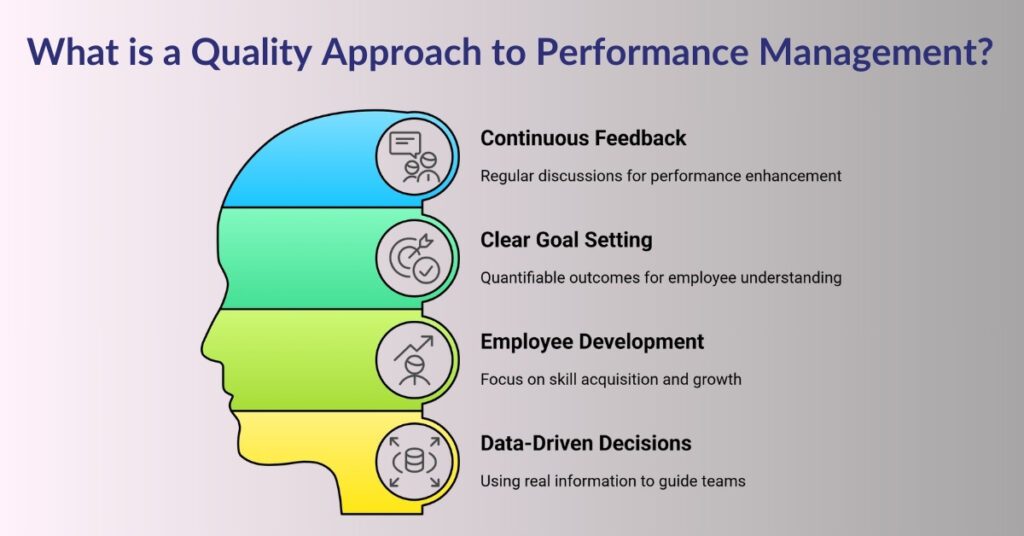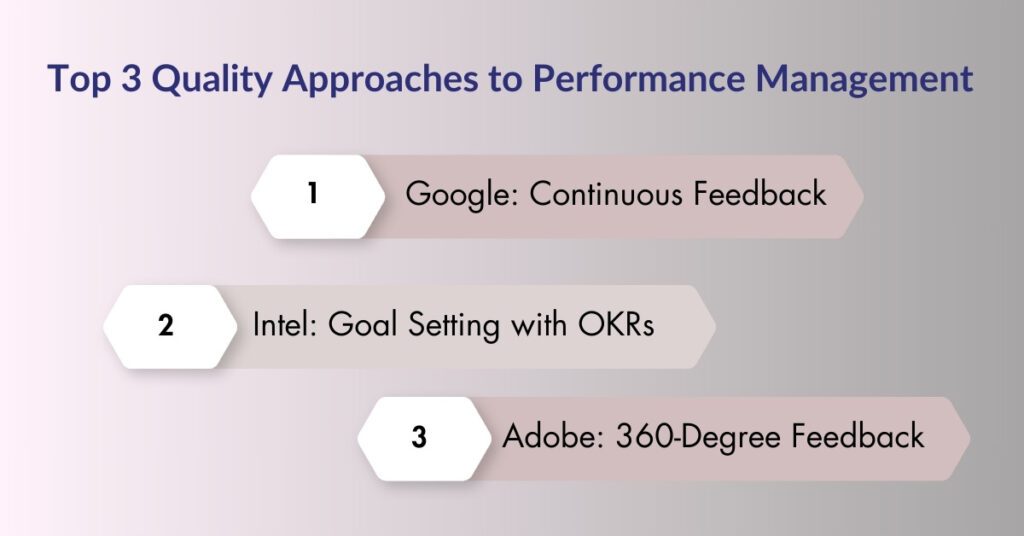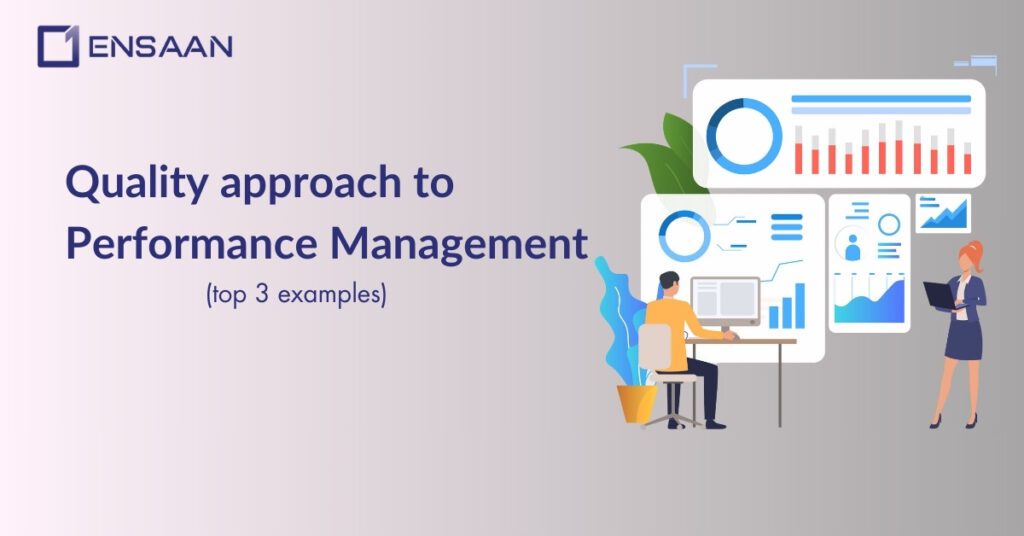Performance management is no longer just a formal, once-a-year review process.
Today, employee development is an ongoing journey designed to assist employees in meeting company objectives while remaining motivated.
Companies that adopt a quality-driven approach to performance management don’t just measure it – they strive to enhance it!
In this blog, we will explore what quality approaches really mean and examine three global companies (Google, Intel and Adobe) which have successfully applied this art form.
Table of contents

What is a Quality Approach to Performance Management?

A quality approach to performance management is an innovative, people-oriented process which strives to make it helpful, honest and growth-focused.
Instead of just judging employees annually, this form of management provides guidance all year long.
Here are its main features:
Here are the main features of a quality approach:
- Performance management focuses on continuous feedback instead of annual reviews, so managers and employees regularly discuss performance, progress and enhancement.
- Performance Management fosters clear goal setting with outcomes that can be quantified, helping employees understand what’s expected of them and how best to meet it.
- Performance management supports employee development and growth, making sure people learn new skills and improve continuously.
- Performance management supports employee development and growth, helping ensure individuals acquire new skills and continually advance.
- Performance management is based on data-driven decisions, where managers use real information to guide and support their teams.
An effective performance management process should create a culture in which employees feel valued, supported and guided to succeed – making performance management meaningful and actionable.
Why the Traditional Method Fails?
The old-fashioned performance review, often held once or twice a year, has several flaws:
- Employees forget past achievements
- Feedback comes too late to fix problems
- Bias and favoritism can affect results
- It creates stress and fear, not motivation
In contrast, a quality approach is fairer, more motivating, and more helpful for both employees and managers.
Top 3 Quality Approaches to Performance Management (With Real Examples)

Let’s take a look at how successful companies like Google, Intel, and Adobe manage performance using innovative and high-quality strategies.
1. Google: The Power of Continuous Feedback
Google is one of the most admired companies in the world, and its performance management system is a big reason why. Instead of one-time reviews, Google practices continuous feedback.
How it Works:
- Regular 1-on-1 meetings between managers and team members
- Feedback after every project or milestone
- Peer-to-peer feedback systems
- Tools like “Google gThanks” to send public recognition
Why It Works:
- Employees don’t wait months to hear feedback
- Mistakes are corrected quickly
- Success is celebrated in real-time
- Builds a culture of openness and improvement
Employee Experience:
Employees at Google feel they are always in the loop. If they do something well, they’re recognized immediately. If there’s an issue, they receive guidance right away.
Tools Used:
- Google Meet and Calendar for check-ins
- Internal tools for recognition and feedback
- People analytics to track feedback trends
Key Takeaway:
Regular feedback is more helpful than once-a-year criticism. Make performance conversations part of your weekly or monthly routine.
2. Intel (and Google): Goal Setting with OKRs
Intel is the birthplace of the popular OKR (Objectives and Key Results) method.
This approach was later adopted by companies like Google, LinkedIn, and Twitter.
What are OKRs?
- Objective: A big goal you want to achieve (e.g., Improve customer experience)
- Key Results: How you will measure that goal (e.g., Increase customer satisfaction score from 80 to 90, Reduce complaints by 20%)
How Intel Uses OKRs:
- Every employee set OKRs that align with company goals
- OKRs are reviewed quarterly
- Success is measured by how many Key Results are achieved
Why It Works:
- Employees have clarity about what’s expected
- Focus stays on results, not busywork
- Goals stay visible and aligned with the bigger picture
Employee Experience:
Instead of vague job expectations, employees know exactly what they’re aiming for. This boosts motivation and accountability.
Tools Used:
- Google Sheets or OKR software like Weekdone, Lattice, or Betterworks
- Dashboards to track progress
Key Takeaway:
Set goals that are clear and measurable. Review progress regularly and celebrate wins along the way.
3. Adobe: 360-Degree Feedback and Regular Check-Ins
Adobe made headlines when it replaced annual reviews with regular check-ins. The company now uses a flexible and employee-friendly performance management model.
What is 360-Degree Feedback?
It means gathering feedback from all directions:
- From managers
- From peers
- From subordinates
- Sometimes even from customers
How Adobe Does It:
- Monthly or quarterly check-ins
- Focus on future goals, not just past performance
- Feedback from multiple sources
- Managers trained as coaches, not judges
Why It Works:
- Encourages teamwork and accountability
- Reduces personal bias
- Builds trust between teams and leaders
- Feedback is well-rounded and accurate
Employee Experience:
Adobe employees feel that performance conversations are helpful, not stressful. They also feel more engaged, as their voices matter in the process.
Tools Used:
- Feedback platforms like Workday and internal Adobe tools
- Anonymous feedback forms
Key Takeaway:
Don’t just rely on top-down reviews. Ask for feedback from everyone who works with an employee. It gives a complete picture.
Other Quality Practices You Can Adopt
Even if you don’t have a big budget or tech tools, you can still adopt these quality practices:
1. Set Clear Expectations
Make sure employees know their role, tasks, and goals. Clarity leads to confidence.
2. Celebrate Wins
Recognize achievements regularly, even small ones. This keeps morale high.
3. Create a Feedback Culture
Encourage everyone to share feedback with respect and honesty.
4. Train Your Managers
Teach leaders how to coach and guide rather than just manage. Leadership makes all the difference.
5. Use Simple Tools
Use free tools like Google Forms, Excel, or Trello to track performance and feedback.
Benefits of a Quality Performance Management System
When companies follow a quality approach, they enjoy several benefits:
- Better employee engagement
- Higher productivity
- Lower turnover rate
- Stronger team collaboration
- More innovation and ownership
It’s not just about improving numbers. It’s about creating a happy, healthy workplace where people want to do their best.

Conclusion
Quality performance management systems don’t focus on being strict but on being smart; helping individuals improve, align, and grow.
No matter which of Google’s continuous feedback systems, Intel’s OKRs or Adobe’s 360-feedback models you use, the end goal remains the same: creating an enthusiastic and efficient team.
Your team’s future performance rests upon the steps taken today.
Are you need help setting up a performance system in your company?
I can help your organization develop an OKR plan and feedback form; and train team members on giving more constructive criticism.
Let’s make performance management an experience your team looks forward to, rather than something they dread!
FAQ
A quality approach means helping employees improve through regular feedback, clear goals, and ongoing support instead of just yearly reviews.
They give feedback too late, rely on outdated information, and often feel unfair or stressful instead of helpful.
Managers and employees talk often weekly or monthly, so issues get fixed quickly and good work gets recognized right away.
OKRs are simple goal-setting tools where you define an Objective (what you want to achieve) and Key Results (how you’ll measure success).
Instead of just a manager’s opinion, employees get feedback from peers, team members, and sometimes even customers for a more balanced view.







